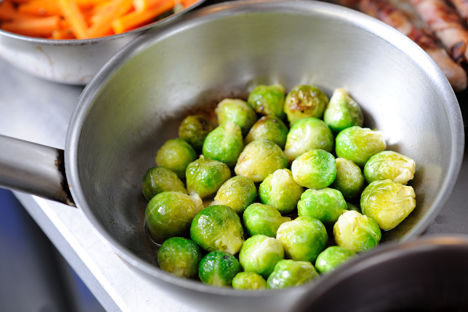Brussels sprouts, once associated exclusively with school dinners and Christmas lunch, are, in fact, delicious when cooked correctly. With the recent surge in popularity of close cousins, kale and broccoli, surely it's time for Brussels sprouts to step back into the limelight.
It is thought that Brussels sprouts originated in Iran or Afghanistan but their enormous popularity in sixteenth-century Belgium led to them being named after the country's capital. Their popularity has since waned – in Britain, at least, where sprouts often feature in 'most hated foods' lists. The reputation of sprouts isn't helped by the fact that they give off a rotten-egg smell when they're overcooked; this is because they contain an organic compound that contains sulphur.
Treat the humble sprout nicely, though, and you'll reap the rewards.
What to look for when buying Brussels sprouts
For centuries, Brussels sprouts have been a winter stalwart as they are able to withstand the frost-bitten months but now they are harvested year round. Still, tradition dictates a surge in demand around Christmas Day, where the inclusion of 'at least one sprout' is customary.
Most supermarkets sell pre-picked sprouts in a net bag but it's often cheaper to buy them on the stalk when available as less labour goes into making them 'shop-ready'. There are lots of different varieties of Brussels sprouts – from the deep-purple Falstaff to high-yield Wellington, sprouts can make the prettiest part of the Christmas plate.
How to cook Brussels sprouts
If the Brussels sprouts are still on the stem, then carefully cut them off with a sharp knife, or give them a sharp twist. Remove one or two of the outside leaves and cut any of the very big sprouts in half so that they cook evenly.
Brussels sprouts don't actually need to be cooked. When finely sliced on a mandoline and tossed with a simple vinaigrette, sprouts make a great salad base. A few wafer-thin Brussels sprout leaves also make a delicate garnish, either raw or quickly blanched in salted water.
To blanch, cook in salted, boiling water for approximately 3 minutes then refresh in iced water.
Sprouts are great for making a speedy purée, as Paul Foster demonstrates with his poached duck which sits on a Brussels sprout purée.
One of the quickest and simplest ways to cook sprouts, though, is to halve and then stir-fry them.
Brussels sprouts can be braised and used in a gratin. When slow-cooked, the flavour often mellows so it's common for other tastes and textures to be introduced – perhaps a creamy mustard sauce in a gratin or smoky bacon when braising.
What goes with Brussels sprouts
Brussels sprouts are most often served with turkey or goose as part of Christmas dinner but their distinct flavour makes them a great partner for game birds, red meat and fish – as demonstrated in Marcus Wareing's recipe for Venison, chocolate, fig, turnip and Brussels sprouts or Shaun Rankin's Roast turbot with sprout leaves.
The most common Christmas flavour pairings are salty bacon and chestnuts but don't be afraid to experiment. Their robust, cabbage-like flavour means that sprouts go well with soy sauce in a stir-fry or with miso in a broth. Sprouts can also be curried and pickled and any leftovers make a killer bubble and squeak (see Graham Campbell's Turkey version for Boxing Day inspiration.)
Get in touch
Please sign in or register to send a comment to Great British Chefs.


